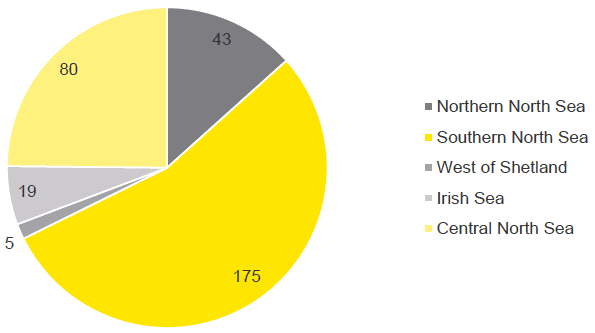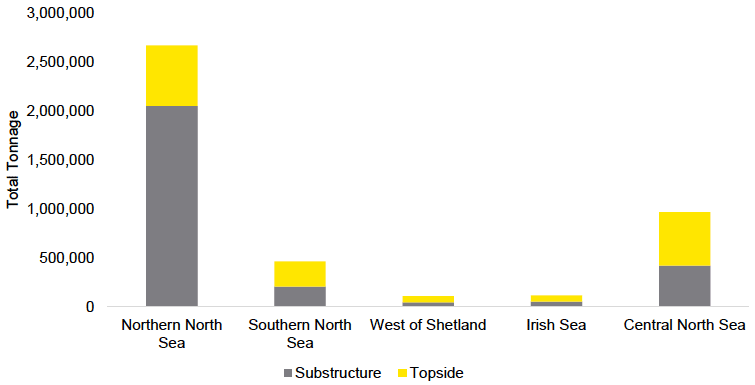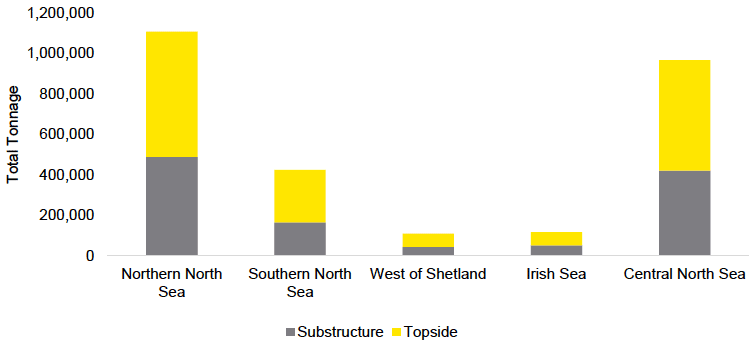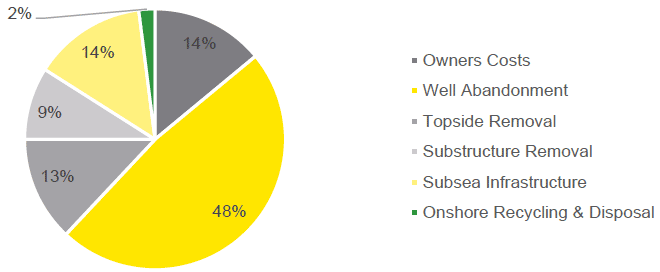Ultra-deep water port: feasibility study
Report compiled by Ernst & Young following their feasibility study looking at the most cost effective locations for an ultra-deep water port in the UK.
Appendix D: Analysis of decommissioning sector
Appendix D provides an overview of the offshore oil and gas UKCS decommissioning market, it covers:
- A breakdown of the current UKCS platforms and floating assets;
- An explanation of the decommissioning process and expenditure forecast; and
- Reviews previous decommissioning projects and future projects that have been submitted to BEIS for approval.
Each area is examined in turn.
UKCS Platforms and Floating Assets
All data used in this section has been collated from the OSPAR list of offshore installations[24], which was refined by EY to account for certain installations which have already been removed to shore for decommissioning.
Location of offshore installations
There are 322 offshore installations, being platforms and floating assets, in the UKCS as at 2018:
- 290 of these installations are platforms with 282 being fixed steel structure, while 8 are gravity-based concrete; and
- The remaining 32 are floating assets.
The installations are grouped across five areas, with the number in each area illustrated by the following figure.
Figure 8: Location of UKCS Platforms and Floating Assets

Source OSPAR
With 175 the majority of these installations are therefore located in the Southern North Sea (SNS), followed by CNS with 80 and NNS with 43.
Platform Tonnage
While the majority of platforms are located in the SNS, these platforms tend to be smaller than those which are located in the CNS and NNS. The average topside weight for a platform located in the SNS is c 1,500 tonnes compared to c18,900 tonnes in the NNS. The total tonnage of platforms sub-structures and topsides located in the UKCS is outlined in the figure below.
Figure 9: UKCS Platform Weights - including concrete gravity based sub-structures

Source OSPAR
In total, platforms in the NNS have significantly greater weight than those in other locations. However, it should be noted that the weights for the NNS include seven sub-structures which are gravity-based concrete. These structures account for 75% of the total sub-structure weight for the NNS. Operators of concrete gravity based sub-structures may be able to apply for derogation from the regulations requiring these parts of the structure to be removed onshore. As such, the total weights presented in the table above, may not directly correlate with the total expected tonnage that will come onshore.
The figure below restates the analysis to remove gravity based sub structures.
Figure 10: UKCS Platform Weights - excluding concrete gravity based sub-structures

Source OSPAR
If the concrete gravity based structures are excluded from the analysis, the total weight of all UKCS assets is 1.2m tonnes for sub-structures and 1.6m for topsides. The majority of platform tonnage is located in the NNS and CNS. These two locations account for 78% of UKCS platform sub-structure tonnage and 76% UKCS platform topside tonnage.
Decommissioning Process
The need for decommissioning
In the oil & gas field life cycle, operators will eventually reach a point where the continued production at the site becomes uneconomical. There are a number of factors which impact this, but a key issue is the prevailing oil price. In periods of long term low oil prices, operators may find that future returns from the field are outweighed by future costs. Once an operator has made its decision to cease production, it needs to apply to the OGA for approval for a permanent CoP.
Following the decision to permanently cease production at a field, an operator must decide what it will do with the assets located at the field - platforms, substructures, pipelines etc. If possible, assets will be re-used elsewhere or, with the exception of some structures, they must be returned to shore for recycling and disposal.
The requirement for offshore operators to perform asset decommissioning is established in UK and international legislation. The most significant obligations for operators are outlined in OSPAR decision 98/3 (OSPAR 98/3) which prohibits the dumping or leaving wholly or partially in place offshore installations. Derogations to allow certain structures to remain in situ can and have been granted in the past. Where no derogation for the requirements is granted, all offshore assets must be removed and re-used or recycled.
The decommissioning process
The activities in a decommissioning process are generally allocated to the phases of work outlined in the table below.
Table 33: Decommissioning work breakdown structure
| Phase |
Description |
|---|---|
| Owner costs |
|
| Well Abandonement |
|
| Topside removal |
|
| Substructure removal |
|
| Subsea Infrastructure |
|
| Onshore recycling and disposal |
|
Source: Oil & Gas UK: Decommissioning Insights 2017, OGA: UKCS Decommissioning 2017 Cost Estimate Report
The feasibility study focuses on the onshore recycling and disposal element of the decommissioning process.
Onshore disposal largely constitutes the work performed by the onshore contractor to dismantle, recycle and where applicable dispose of materials from installations transported onshore.
Total Decommissioning Costs
Using operator feedback, the OGA has performed a costing exercise to estimate the total costs of decommissioning across the UKCS[25]. The approach used was to determine a probalistic cost estimate which captures the high degree of uncertainty in current decommissioning cost estimates. This provided a cost distribution of £44.5bn to £82.7bn with the OGA using £59.7bn as its base for future cost reduction targets.
The OGA used the information collected from operators to apportion costs to the decommissioning phases, this is illustrated in the following figure:
Figure 11: Decommissioning costs per WBS

Source: OGA
This demonstrates:
- Well abandonment is the most significant category of cost accounting for 48% of expected expenditure;
- Topside and substructure removal combined account for 21% of expected future costs; and
- Onshore recycling & disposal is the smallest expected cost category at 2%. When considering this within the context of the decommissioning cost estimates from the OGA, this would amount to expected expenditure between £890m and £1.7bn. According to the OGA's base estimate the cost of onshore recycling and disposal is £1.2bn.
Decommissioning projects
Approved decommissioning projects
A number of decommissioning projects have already been completed in the UKCS to date which provide an evidence base of decommissioning methodologies, vessels and disposal yards used in the process. A list of BEIS approved platform decommissioning projects since 2007 onwards is outlined in the table overleaf.
Table 34: Approved decommissioning projects
| Platform | Operator at approval | Basin | Topside Weight (Tonnes) | Jacket Weight (Tonnes) | Methodology | Vessel | Disposal Yard | |||
|---|---|---|---|---|---|---|---|---|---|---|
| Audrey A (WD) | Spirit Energy North Sea Limited | SNS | 1,276 | 1,063 | Not available | |||||
| Audrey B (XW) | SNS | 1,298 | 865 | Not available | ||||||
| Markham ST-1 | Centrica Production Nederland B.V. | SNS | 1,299 | 1,219 | Reverse Engineer | Stanislav Yudin | Not available | |||
| Vulcan UR | ConocoPhillips (U.K.) Limited | SNS | 916 | 1,138 | Reverse Engineer | Not available | ||||
| Viscount VO | SNS | 330 | 731 | |||||||
| Vampire OD | SNS | 345 | 587 | |||||||
| Leman | Shell U.K. Limited | SNS | 1,039 | 566 | Reverse Engineer | Not available | Greater Yarmouth | |||
| Janice (FPU) | Maersk Oil UK Limited | CNS | 30,600 | n/a | Towed to shore | N/a | Vats, Norway | |||
| Viking - CD | ConocoPhillips (U.K.) Limited | SNS | 172 | 1,185 | Not available | |||||
| Viking - DD | SNS | 171 | 756 | |||||||
| Viking - ED | SNS | 409 | 752 | |||||||
| Viking - GD | SNS | 164 | 586 | |||||||
| Viking - HD | SNS | 164 | 743 | |||||||
| Horne & Wren | Tullow Oil SK Limited | SNS | 90 | 455 | Reverse Engineer | Rambiz | Holland | |||
| Thames Complex AP | Perenco UK Limited | SNS | 6,488 | 1,100 | Reverse Engineer | Rambiz | Holland | |||
| Thames Complex AW | SNS | 2,035 | 950 | |||||||
| Thames Complex AR | SNS | 406 | 600 | |||||||
| Brent Delta | Shell U.K. Limited | NNS | 24,200 | n/a | Single lift | Pioneering Spirit | Able Seaton, UK | |||
| Murchison | CNR | NNS | 24,584 | 24,640 | Reverse Engineer and piece small | Thialf | Vats, Norway | |||
| Miller | BP Exploration (Alpha) Limited | NNS | 28,732 | 18,584 | Reverse Engineer | Saipem 7000 | Kvaerner Stord, Norway | |||
| Camelot CA | Energy Resource Technology (UK) Limited | SNS | 1,220 | 600 | Reverse Engineer | Rambiz | Holland | |||
| MCP-01 | Total E&P UK Limited | NNS | 13,500 | 0 | Piece Small and Reverse Engineer | Saipem 7000 | Greenhead Base, Lerwick and Kvaerner Stord, Norway | |||
| Juliet-D | Shell U.K. Limited | SNS | 2,345 | 910 | Piece small and reverse Engineer | Stanislav Yudin | Swan Hunter, Newcastle | |||
| Juliet-P | SNS | 655 | 363 | |||||||
| Kilo | SNS | 2,818 | 816 | |||||||
| Lima | SNS | 1,448 | 836 | Reverse Engineer | ||||||
| Mike | SNS | 522 | 637 | |||||||
| November | SNS | 495 | 703 | |||||||
Source: https://www.gov.uk/guidance/oil-and-gas-decommissioning-of-offshore-installations-and-pipelines, https://www.ogauthority.co.uk/data-centre/data-downloads-and-publications/infrastructure/
Of the 28 platforms, reverse engineering was used in some form on all occasions except two, highlighting that has been the most frequently used method in the decommissioning industry. For MCP-01, Juliet-D, Juliet-P and Kilo, where piece small decommissioning was used, close out reports for these projects highlighted that the use of piece small led to an increased expenditure.
The majority of decommissioning projects have been on smaller platforms which are based in the SNS. These projects have used smaller crane vessels such as the Stanislav Yudin or the Rambiz. Larger structures, such as the Miller, Murchison and Brent Delta have used UHLVs or SLVs for their decommissioning projects.
The Janice Floating Production Unit was towed to shore using the same methodology employed for the Buchan Alpha floating production vessel. Highlighting that the decommissioning of floating structures does not necessarily require UHLVs or SLVs.
The Brent Delta platform, which was decommissioned via single lift was the second platform to be removed in this manner. It set a world lifting record and effectively demonstrated the methodology as viable for large scale decommissioning projects going forward.
No projects on the list using an UHLV have been taken to the UK for decommissioning. As noted in the MCP-01 close out report:
'Initially the intention was that 100% of the topsides would be sent to Shetland. However, the decision to remove the large modules using the Saipem 7000 and transporting them on deck to shore meant that Shetland could not be used for that purpose as the water depth at quayside is insufficient. In the final accounting some 5400 tons went to Shetland and the remainder - 9600 tons - went to Stord.'
This issue is further highlighted in an article discussing the Miller decommissioning project
'This does require access to an ultra-deepwater quayside and port so that the S7000 can remain ballasted down at transit depth until off-load is complete. Given the current lack of such facilities in the UK, Saipem has opted to take the Miller sections to the Kværner Stord AS yard in Norway for final disposal and recycling'[26].
Thus highlighting vessel operators' unwillingness to bring decommissioning projects using UHLVs to the UK due to a lack of an UDW port.
As such, from a review of past decommissioning programmes it appears that UHLV will be required to decommission larger structures which tend to be focused in the NNS. For smaller structures, typically found in the SNS, smaller vessels are used, while floating units can be towed to shore.
Planned decommissioning projects
The table below outlines planned projects which have decommissioning programmes submitted with BEIS for approval.
Table 35: Planned UKCS decommissioning projects
| Platform | Location | CoP | Expected topside removal timing | Expected jacket removal timing | Topside weight | Jacket Weight | Decommissioning methods being considered |
|---|---|---|---|---|---|---|---|
| Windemere | SNS | 2016 | 2021 | 2021 | 452 | 382 | Reverse engineer with small HLV |
| Jacky wellhead platform | MF | 2017 | 2022 | 2022 | 663 | 596 | Reverse engineer with small HLV |
| East Brae | NNS | 2020 | 2021 | 2023 | 20,000 | 10,054 | All considered |
| Brae Alpha | NNS | 2021 | 2023-2025 | 2026 | 30,200 | 20,000 | All considered |
| Brae Bravo | NNS | 2018 | 2026-2028 | 2029 | 36,200 | 22,000 | All considered |
| Ninian Northern Platform | NNS | 2017 | 2019-2020 | 2032 | 12,453 | 15,561 | All considered |
| Brent Alpha | NNS | 2014 | 2021 | 2022 | 16,000 | 10,113 | Single lift |
| Brent Bravo | NNS | 2014 | 2020 | N/a | 24,100 | Leave in Place | Single lift |
| Brent Charlie | NNS | tbc | Not before 2025 | N/a | 31,000 | Leave in Place | Considering HLV, SLV or piece small |
Source: https://www.gov.uk/guidance/oil-and-gas-decommissioning-of-offshore-installations-and-pipelines
Of the planned decommissioning projects, those with smaller tonnages have outlined plans to use smaller HLVs, which is in line with past projects.
The Brent Alpha and Brent Bravo platforms will use the single lift removal method which is in line with the method used on the Brent Delta field. All other decommissioning programmes outline they will select the appropriate method following a tendering process with removal operators. As such, there does not appear to be a clear correlation between the characteristics of a platform and the preferred decommissioning method.
For the large platforms, topside removal is expected to be between one and ten years following CoP with substructures generally being removed the following year. Even within these expected timeframes, operators often highlight in decommissioning programmes that topside removal could take place over a three to four year window of opportunity. As such there is no clear definition of when a topside could be removed and may ultimately take place when market and other conditions prove favourable for the operator.
Decommissioning Market Summary
The key findings from the decommissioning market overview are as follows:
- There are over 300 platforms in the UKCS. While the majority are located in the SNS, the largest structures are based in the CNS and NNS.
- The overall expected expenditure on UKCS platform decommissioning is estimated at £59.7bn, with onshore recycling and disposal activities estimated to account for £1.2 billion, 2%, of it.
- Reverse engineer decommissioning has been frequently applied, either for the full removal or as part of the process of completed decommissioning projects. Large platforms using this method require the use of an UHLV. Due to a lack of UDW at UK ports, all projects using an UHLV have been taken to Norway, where there are ports with UDW.
- The successful completion of the Brent Delta platform decommissioning using SLV effectively demonstrated the methodology as viable for large scale decommissioning projects going forward.
- Going forward, there is expected to be competition for each platform from existing UHLVs and SLVs, with the potential for new solutions to enter the market due to the long timespan of the remaining platforms.
- Selection of the removal method is likely to be driven by a number of factors such as cost, complexity of the platform, operator confidence in the vessel operator, health and safety considerations and other requirements.
Contact
Email: Claire Stanley
There is a problem
Thanks for your feedback